Nothing Found
Sorry, no posts matched your criteria
Sorry, no posts matched your criteria

Spiegel magazine has reported that two German warships are set to sail through the Taiwan Strait in the coming weeks, becoming the first German naval vessels to do so in 22 years. Germany will join a growing number of Indo-Pacific and European nations that regularly sail through the Taiwan Strait to challenge Beijing’s claims that the Strait is ‘internal waters’ belonging to China.
The Chinese government rejects the notion that the Strait should be ‘used for international navigation’, as defined by article 37 of the United Nations Convention on the Law of the Sea (UNCLOS). Beijing has determined that the Strait is too narrow to be defined as ‘high seas’ and has outlined that the waters of the Taiwan Strait, ‘from both shores towards the middle of the Strait, are China’s internal waters, then territorial sea, the contiguous zone and then exclusive economic zone’. Beijing incorrectly maintains that innocent passage by foreign militaries in the Taiwan Strait violates its sovereign rights.
Countries challenge Beijing’s unilateral determination by using military assets to undertake transits of the Taiwan Strait, simultaneously reinforcing UNCLOS and the need for unimpeded transit and a free and open Indo-Pacific region. However, not all countries choose to take the same approach. Some countries use transits to publicly challenge China and reinforce the need for international laws and norms, while others quietly pass through the Strait, making their presence known to Beijing, whose ships are always closely following behind.
Publicly available data indicates that the following countries are active in the Taiwan Strait:
| Country |
Conducts TST |
Conducts multiple TST |
Regular pattern of TSTs |
Country publicises TSTs |
Transits with partners |
Transits with aircraft |
USA |
✓ | ✓ | ✓ | ✓ | ✓ | ✓ |
Canada |
✓ | ✓ | ✓ | ✓ | ✓ | |
Australia |
✓ | ✓ | ✓ | |||
UK |
✓ | ✓ | ✓ | |||
France |
✓ | ✓ | ||||
Germany |
✓ | ✓ | ||||
Netherlands |
✓ | ✓ | ||||
Turkey |
✓ |
TST = Taiwan Strait Transit
Japan, South Korea and New Zealand are notable absences from this list. Their militaries are active throughout the region, but their governments either chose to take a very quiet approach to any military activity in the Taiwan Strait or to avoid the Strait completely. New Zealand has challenged China’s claims elsewhere, including in the South China Sea, however there is no public reporting of their military passing through the Taiwan Strait.
Other countries, such as the United States, are very active in the Strait. Throughout 2023, US warships transited the Strait six times. US Navy P-8 Poseidon aircraft also conduct flyovers of the Strait. Such activities are publicised by US defence media, underscoring that the US will continue to uphold navigational rights and operate anywhere international law allows.
The US have also recently started to transit the Strait with Canada. A June 2023 joint transit angered Beijing, with a Chinese warship cutting across the bow of the US destroyer in a move categorised as unprofessional. Canada has increased its presence in the Strait with recent reports indicating that Canada now transits the Strait three times a year with this number likely to increase in the future. Canada has also followed the US and The Philippines in placing journalists onboard their military vessels, including those transiting the Strait, to increase awareness back home of the challenges their sailors face from an increasingly aggressive China.
Australia is the final country that likely conducts regular transits of the Strait. However, as the Australian government does not advertise transits, the tempo is difficult to determine. China challenged an Australian transit all the way back in 2001, while another transit was confirmed by Taipei as late as November 2023.
Both the UK and France appear open to transiting the Strait when naval vessels are in the region. The French confirmed that a Floréal-class surveillance frigate sailed through the Strait soon after President Macron’s 2023 visit to Beijing. In 2021, HMS Richmond confirmed via tweet its intent to sail through the Strait while deployed to the region with Britain’s carrier strike group.
Germany will follow the Netherlands, and surprisingly Turkey, as nations that are using 2024 naval deployments to the Indo-Pacific to challenge China’s illegal claims. Sadly, there has yet to be any indication that Italy transited the Strait during the recent deployment of its carrier strike group to the region.
China has a common playbook to respond to these transits. Vessels from China’s navy, and sometimes coastguard, closely follow any foreign military vessel through the Strait, and as demonstrated in 2023, they are willing to push boundaries to intimidate others. This military action is paired with stern diplomatic representations in both Beijing and foreign capitals.
As we have seen with Germany’s upcoming transit, when plans are made public, China will go on the offensive. China has warned Germany against provocation and actions that will ‘harm China’s sovereignty and security’. But Germany’s actions are to be commended. Advertising the transit reinforces value of countries taking actions that push back against China’s unilateral determinations, while upholding the importance of freedom of navigation in the Indo-Pacific.

No doubt the Chinese military was paying attention.
Last month the United States disassembled and removed the floating pier it had assembled at a Gaza beach to take aid deliveries.
Heavy seas beat it. Such a pier supposedly can be assembled in hours, but this one took almost a month. When it was operational, waves damaged it, and it repeatedly had to be pulled away from the beach to prevent its destruction. Once it had to be towed to a port for repairs. Waves drove ashore boats that serviced it.
And all that was nothing compared with the challenges that China’s armed forces would face in trying to deliver a mountain of personnel, equipment and supplies in an invasion of Taiwan. The pier’s lesson for China is that invading the island would be a doomed endeavour.
The weather of the Taiwan Strait makes the eastern Mediterranean look like a bathtub. Defenders would attack China’s piers. Almost every beach where China might want to build floating piers is overlooked by terrain that would turn the unloading zones into kill zones.
Even before those problems arise, building and installing a floating pier is a huge exercise. The US Department of Defense budgeted $230 million for the one at Gaza, called the Trident Pier. It was operational for 20 days—less than half of the time after it was positioned—and handled only about 9000 tonnes of supplies.
Logistics is almost always harder than planned, but joint logistics over the shore (JLOTS)— moving people and things from ships to land without a port—is subject to innumerable kinds of friction.
Any Chinese invasion of Taiwan would require improvised piers in many locations simultaneously. They’d be part of a logistical effort that would be enormously larger than anything the Chinese navy has attempted. Even optimistic estimates of just 300,000 personnel for an invasion force would be double the international forces fighting in Afghanistan at the height of the global war on terror.
Higher estimates suggest an invasion of Taiwan could need as many as 2 million soldiers. Few of them, and very little of their equipment and supplies, could go by air. Almost everything would have to cross the strait in ships.
Taiwan’s seven major ports would almost certainly be contested, guarded by sea drones and subject to sabotage.
The island has 14 beaches usable for military landings. All but one are surrounded by cliffs and urban jungles, perfect places for the Taiwanese army to hide forces that would attack anything coming ashore and anything used in bringing it ashore, including the piers themselves.

Mother Nature would be doing her bit, too. Indeed, her efforts may be enough to prevent using the beaches in the first place.
Also called the Black Ditch, the strait is known for ‘… strong winds, wave swells, and fog…’ half the year. The storms, heavy rain and squally winds of monsoon seasons sweep it and the coasts on either side. An average of six typhoons hit the strait each year. As Ian Easton details in his book The Chinese Invasion Threat, the weather of the strait shrinks the windows available for an invasion to just two months of ‘good suitability’: April and October. That is a narrow time constraint that worsens a vast logistics challenge.
Apart from soldiers and their equipment, the Chinese navy would need to ferry food, fuel and ammunition to them. The landing alone could require 30 million tonnes going ashore, which far outstrips the capacity of the Chinese navy’s amphibious transport fleet.
Recognising this, the navy is incorporating civilian roll-on, roll-off ferries (roros) as reinforcements. While China has fewer than 50 roros today, it could have two or three times as many by 2032.
That still leaves the problem of getting over the beach. China should view the story of the Trident Pier as a cautionary tale. JLOTS operations are technically complex, costly and risky. The security threat to the improvised pier at Gaza was hardly comparable to the one that Taiwan and its friends would present to a Chinese cross-strait amphibious operation. Nor were the weather challenges comparable, though the sea state off Gaza was still bad enough to ensure the US pier was usually not functional.
The money that the US spent on the pier also paid to show China just how hard JLOTS can be. If that lesson deters war, it was a cheap price to pay.

It’s early days, but the signs are strong that Taiwan’s new government will insist on much more of a porcupine strategy for national defence than many officers in the country’s hidebound armed forces have been willing to accept.
If it succeeds, the island should be far more capable of fending off a conquest by China, and the armed forces will have to give up some of the traditional and glamorous but highly vulnerable weaponry that they are so fond of.
Much of the defence budget would shift to small and easily hidden systems that could threaten an invasion fleet, ground forces that have landed or aircraft supporting them. From China’s point of view, Taiwan would resemble a porcupine, covered in innumerable quills and hard to touch.
President Lai Ching-te of the Democratic Progressive Party took office in May. His
new defence minister, Wellington Koo, set out key aspects of military policy direction in an initial report to the legislature in June.
This included developing ‘asymmetric warfare’, a term used in Taiwan for the porcupine strategy. The focus would be on achieving ‘precision, mobility, lethality, dispersion, survivability and cost effectiveness,’ Koo said. A little over a week later, Koo doubled down, saying that the island’s strategy of deterrence would be based on ‘asymmetric’ thinking.
The porcupine strategy has become Taiwan’s most efficient means of defence because the island can no longer match China conventionally—say, by meeting high-performance fighters with comparable aircraft in comparable numbers. In those circumstances, it cannot apply its former strategy of fighting China’s forces across the breadth of the Taiwan Strait and wearing them down through attrition. Taiwan’s defence budget for 2024 is NT$606.8 billion ($27.6 billion), dwarfed by China’s official military spending of 1.6 trillion yuan ($327 billion), which doesn’t include all spending on the armed services.
The porcupine strategy would focus on a decisive battle in Taiwan’s littoral, where Chinese forces would be most easily detected and hit. Weapons and sensors would tend to be small, cheap, numerous and easily hidden; many would have only short range. For example, Chinese warships could be attacked using sea mines or with missiles mounted on trucks that were dispersed and concealed in Taiwan’s forests or cities. Much of the budget would shift away from buying expensive and conventional equipment, such as big armoured vehicles and fighters.
‘The Ukraine war has given us a big lesson that, even if you are the smaller one or the weaker one, you still have a chance to survive and resist successfully,’ says retired Admiral Lee Hsi-ming, who created the porcupine approach in what was called the Overall Defense Concept. It was adopted in 2017 but, Lee said in an interview with The Strategist, abandoned by the military two years later.
Lai, inclined towards Taiwanese independence, may have appointed Koo to shake things up. Formerly the head of Taiwan’s national security council, Koo is Taiwan’s first civilian minister of national defence in more than a decade. To Taiwan’s military, he is an outsider.
The armed forces have resisted adopting the porcupine strategy obviously because officers want to keep combat modes that they’re accustomed to and like big, flashy equipment that they can be proud of. Apart from fighters that could hardly be kept operational on airfields plastered by Chinese strike missiles, examples include four 10,000-ton destroyers that would be easily sunk if they stayed anywhere near the island in a war.

Historical legacy worsens the military’s rigid top-down culture and bureaucratic resistance to change: it was once part of the then authoritarian Nationalist Party (KMT), which imposed dictatorship on Taiwan from 1949 to 1987. Previous defence ministers have often been retired generals or admirals, who have tended to allocate funds and choose programs to suit the desires of the service they came from, regardless of the needs of national defence.
Taiwanese defence analysts close to the military have defended such choices. Lately they’ve tried to argue that the visible presence of big and expensive weaponry is good for public morale. They add that China gets a deterrent message from the United States when such equipment is sold to Taiwan. This dodges the problem that the stuff can be quickly obliterated in a war.
Perhaps the best argument for conventional defence equipment is that some of it, such as the F-16 fighter force, is needed to counter China’s grey zone warfare. During peacetime, warplanes help to ward off China’s frequent incursions into Taiwan’s air defence identification zone.
The United States has been pushing Taiwan to adopt a porcupine strategy and has refused to supply weapons that don’t suit one. For example, insiders say, in 2022 it rejected a Taiwanese request for Sikorsky MH-60R anti-submarine helicopters, which would be easily shot down.
But the United States has approved supply of two kinds of loitering munitions (one-way drones) to Taiwan: Switchblade 300s and Altius 600M-Vs. Inexpensive and launched by small groups of soldiers who would be hard to detect, those are the sorts of weapons that would make sharp quills on the porcupine.

Because Taiwan lacks formal diplomatic ties with most countries, it works hard at developing cultural and social links with them.
But not with Japan. Far more than is widely understood in other countries, Taiwan and Japan have an unusually close cultural and social relationship that doesn’t need government promotion. Their relationship might even be called cozy.
This must be an influence in international policy. Japan has its own national-security reasons for backing Taiwan’s preservation from Chinese conquest, but the mutual fondness between the two countries can only reinforce Tokyo’s resolve.
Most surprisingly, the close Taiwan-Japan relationship is based largely on nostalgia for colonialism. Many Taiwanese even feel reverence for their former Japanese colonial masters, who modernised the island during an occupation that lasted from 1895 to 1945.
More than anything, that colonial nostalgia is the doing of the Kuomintang, the nationalist party that lost China’s civil war to the Communists and came to the island in 1949. Japanese rule had been tough, but the Kuomintang’s was brutal.
Comfort, or even fascination, with a history of Japanese colonialism is a strong cultural factor that sets Taiwan apart from China and South Korea, where occupation by Japan is remembered with revulsion. Last year, Taiwan’s de facto embassy in Japan found in a survey that 77 percent of Japanese said they felt close to Taiwan and 73 percent believed that Taiwan and Japan had good relations. A year earlier, Tokyo’s representative office in Taiwan had conducted a similar survey, finding that Taiwanese had much the same feelings towards Japan.
Japan suddenly became aware of the depth of Taiwan’s affection for it after the 2011 Fukushima nuclear disaster, when an outpouring of Taiwanese donations exceeding 20 billion yen (US$230 million at the time) outdid contributions from every other country. It was a watershed moment for Japan.
Since then, Japan has repaid this friendship. For example, after China suspended imports of Taiwanese pineapples in 2021 in an apparent attempt to squeeze the island’s economy, Japan stepped in to buy loads of the fruit.
When a powerful earthquake hit the Taiwanese city Hualien in April this year, Japanese local governments and private citizens ran fund-raising campaigns. Hualien subsequently suffered from a drop in tourism, so diplomats in Japan’s de facto embassy in Taiwan encouraged Japanese expatriates on the island to visit the city.
Taiwanese visitors were the biggest spenders in Japan last year, even edging out Chinese ones. Taiwan is an unusually popular travel destination for Japanese. In 2019, before the Covid-19 pandemic distorted Japanese travel patterns, 11 percent of overseas trips by Japanese were to Taiwan, compared with 9 percent to Thailand, which is far more famous elsewhere for holidays.
Although Taiwanese are ethnically Chinese, they are culturally very different to the people of China. Much of that difference comes from Japanese colonial influence that permeates Taiwanese society. In Taiwan, the local Chinese dialect includes Japanese words, tatami mats are found in many homes, and big dollops of wasabi are routinely served with seafood. As for more modern influences, many young Taiwanese are keen to learn Japanese so they can read original editions of manga. They copy Japanese fashion, too.
The closeness between Taiwan and Japan isn’t just cultural and social. Mutual trade is booming. Japan is Taiwan’s third-largest trading partner and Taiwan is Japan’s fourth-largest. Japan has also voiced support for Taiwan’s participation in the Comprehensive and Progressive Agreement for Trans-Pacific Partnership, a proposed multilateral free trade pact
Amid concerns that concentration of advanced integrated-circuit manufacturing in Taiwan creates a global vulnerability, Taiwan’s star chipmaker, TSMC, has been lured to set up shop in Japan, the United States and Germany. In February it said it would add a second chip factory in Japan and increase investments there to more than US$20 billion. The word in Taipei is that TSMC’s Japanese ventures are operating more smoothly than those it has in the United States, thanks to cultural similarity.
In 2021, Taiwan worried that its stock of Covid-19 vaccines was running low, because, the government said, China had interfered with the island’s supplies. Japan responded with a donation larger than any other country’s.
Political connections are getting closer, too, even though they are more sensitive than culture and trade, because of China’s hostility. Also, old-guard members of the Kuomintang, remembering Japanese atrocities in China during and before World War II, are not fond of Japan. But the party has not held the presidency since 2016.
Parliamentary diplomacy serves as a Taiwanese channel for discussing security issues with another country. It’s vibrant with Japan. In 2021, Taiwan, Japan and the United States launched a trilateral strategic forum involving lawmakers from all three nations. That year, Taiwan and Japan also launched what they call 2+2 talks, in which two ruling party lawmakers from each side with expertise in defence and foreign affairs would meet twice a year.
The message from all this is simple: to each other, Japan and Taiwan are much more than near neighbours.

The 20 May 2024 inauguration of Taiwan’s new president, Lai Ching-te, was an exuberant and giddy celebration of democracy. The square in front of the presidential office was filled—with performers dressed as food, dancers moving around a giant blue horse, hip-hop artists rapping, and a hard-rock band roaring out lyrics all about ‘Standing Up Like a Taiwanese’.
This message summed up Lai’s inaugural speech as well as the feeling in the crowd. What really got the crowd cheering was the new president and his vice president making the heart sign with their hands and dancing on the stage.
The event was uniquely Taiwanese. I was part of the crowd and pleased to be back in Taipei to see this peaceful transition and example of democracy in action, all this taking place just across the straits from the People’s Republic of China.
I am unwelcome in Beijing, having visited Taiwan in 2021 while I was the US ambassador to Palau. The trip was to mark the opening of a pandemic travel bubble between Taiwan and Palau. I accompanied Palau’s president, Surangel Whipps, Junior, on this historic visit. Palau’s president was also back in Taipei at the time of the inauguration last month, representing one of the 12 remaining countries that continue to recognise Taiwan as a sovereign nation.
The date 20 May has historic significance for Taiwan. It marks two key events in its transition to democracy—from the declaration of martial law in 1949 to the first free election of a Taiwanese president in 1996.

The 2024 inauguration was notable for the happiness and confidence that was evident in the gathered crowds. Despite threats from Beijing, the Taiwanese people are resilient and proud of what is taking place in their island. They have a vibrant democracy (too vibrant sometimes—note scenes in its parliament of representatives scuffling), a dynamic economy that produces more than 90 percent of the world’s most sophisticated silicon chips, and an increasing realisation that it is the people of Taiwan who must determine its future and be prepared to defend what is a great success story.
The Taiwanese people are generally pragmatic and appear comfortable with the status quo in relation to China. The public’s declining desire for political union with China has fallen to record low levels according to biannual polls conducted by Taiwan’s National Chengchi University’s Election Study Center. Taiwanese people want and will need the help of their friends like the United States to secure this peaceful future.
China’s reaction to Taiwan’s new president has been as negative as expected. Official statements have labelled Lai a ‘troublemaker’. There has been no interest in his invitation to resume talks on the future status of Taiwan. Chinese officials have declared Taiwan independence a dead end.
Here in Taipei, the Taiwanese people I have met don’t seem intimidated by the threat of an invasion from the mainland. Yes, all qualified men are required to serve a year in the military, and the government is increasing its defence spending. But in an echo of one Pacific leader’s statement, Taiwan’s people seem sincere in their desire to be friends with everyone and the enemies of no one. I am struck by the positive outlook young Taiwanese have about their future. This is despite the near daily incursions into Taiwan’s military defence zone by the Chinese navy and air force.
The peaceful transition and inauguration of the new president was a celebration of Taiwan’s success—and deservedly so.

Under the theme ‘Weaving Taiwan’s story and advancing democracy’, Lai Ching-te was inaugurated as the new president of Taiwan on May 20, closing the era of his predecessor, Tsai Ing-wen. The incoming administration will build on Tsai’s legacy, but the international community will need to adjust to a new and less disciplined political tone will arise from internal party politics, a new legislature and domestic policy concerns.
Lai and Vice President Hsiao Bi-khim were elected in January with 40 percent of the vote, well clear of rival candidates in a three-way race. But Lai’s party, the Democratic Progressive Party (DPP), lost its legislative majority, falling to 51 seats in the 113-seat legislature. The main opposition party, the Kuomintang (KMT), has 52, the Taiwan People’s Party (TPP) eight, and there are two KMT-aligned independents.
Although Lai campaigned on absolute continuity with Tsai’s governance, the result can be read as expressing voter satisfaction with the DPP’s handing of Taiwan’s security and foreign relations but discontent with various domestic issues, especially housing affordability and wage growth.
Lai’s choices for members of his government are responses to voter sentiment and internal DPP politics.
A key appointment is Cho Jung-tai as premier. Cho will head the cabinet and manage relations between the executive and legislature. Since the DPP lacks a majority, his performance will be particularly important for implementing Lai’s legislative agenda. Cho is up against the KMT’s new speaker of the legislature, Han Kuo-yu, a populist political warrior who decisively lost to Tsai when running against her for president in 2020.
Days before the inauguration, a violent scuffle broke out in the legislature over an attempt by the opposition parties to push through contentious legislature reforms without debate. The incident points to four challenging years ahead.
Domestic policy is in the hands of new interior minister Liu Shyh-fang, from the southern city of Kaohsiung, and Chuang Tsui-yun, who is retaining the finance portfolio. Liu is one of the DPP’s leading women from the south, while Chuang has no party membership. High-profile minister for digital affairs Audrey Tang, who came out of Taiwan’s anarchic hacker scene, has been replaced by Huang Yen-nun, a semiconductor researcher and industry veteran.
The new ministers have extensive government experience, benefiting from the party’s incumbency and its professionalisation since its beginnings as an anti-authoritarian democracy movement in the 1970s.
But Lai is also drawing on his southern Taiwan powerbase. While Liu has come from Kaohsiung, Chen Shu-tzu, known as a tough administrator, has been brought up from the city government of nearby Tainan to head the Directorate General of Budgeting, Accounting and Statistics. She was a Lai ally when he was mayor of Tainan in the 2010s. Lai reinforced the message by holding his official inauguration dinner in Tainan, not Taipei.
Tsai also dealt with internal party dynamics as president, but her path to power, unusually, did not include a city mayorship, which helped her develop a role in the party as a leader above the fray.
For Australia’s relationship with Taiwan, the most important appointment is that of Lin Chia-lung as foreign minister. A DPP heavyweight, he has been in a wide range of roles at the city and national levels, including a stint as transport minister under Tsai. He will benefit from outgoing minister Joseph Wu’s work to develop a a more open and dynamic culture in the Ministry of Foreign Affairs. The new defence minister is Koo Li-hsiung, a civilian. He is not the first civilian in the job, but his appointment still signals a continuing commitment to defence reform.
Also important for Australia is the new minister for economic affairs, Kuo Chi-hui, who covers trade policy. His career has been in business, not politics, and he is taking over from Wang Mei-hua, with whom Canberra has had an excellent relationship.
The two other figures of importance for the incoming government are Vice President Hsiao Bi-khim and Tsai. Hsiao is one of the government’s strongest assets, with a formidable and hard-won skillset in both domestic politics and foreign affairs, but the role of vice president has always been somewhat undefined in the Taiwanese system. How Hsiao exercises her experience in foreign affairs and her own political vision within the government may prove important for Lai’s presidency. Tsai meanwhile has yet to declare a post-politics role, but Lai will have to reckon with her power in the party and her presidential legacy.
For its part, Beijing has seemed non-plussed by the election result, continuing its military activity, including encroaching on the island of Kinmen, and furthering a new program to connect with the Taiwanese through what it imagines are shared southern Chinese cultural traditions. It has also hosted visits of leading KMT figures to China.
These are familiar tactics, but intensity ratchets ever higher, and Beijing will recalibrate its threat level against Taiwan again to respond to the start of the Lai era.
The world is focused on Gaza, but Beijing and the international community will still have to adjust to Lai’s leadership, as well as a noisier domestic political dynamic within the parties and especially within the legislature, which can be easy to misinterpret without a substantive understanding of the Taiwan story.
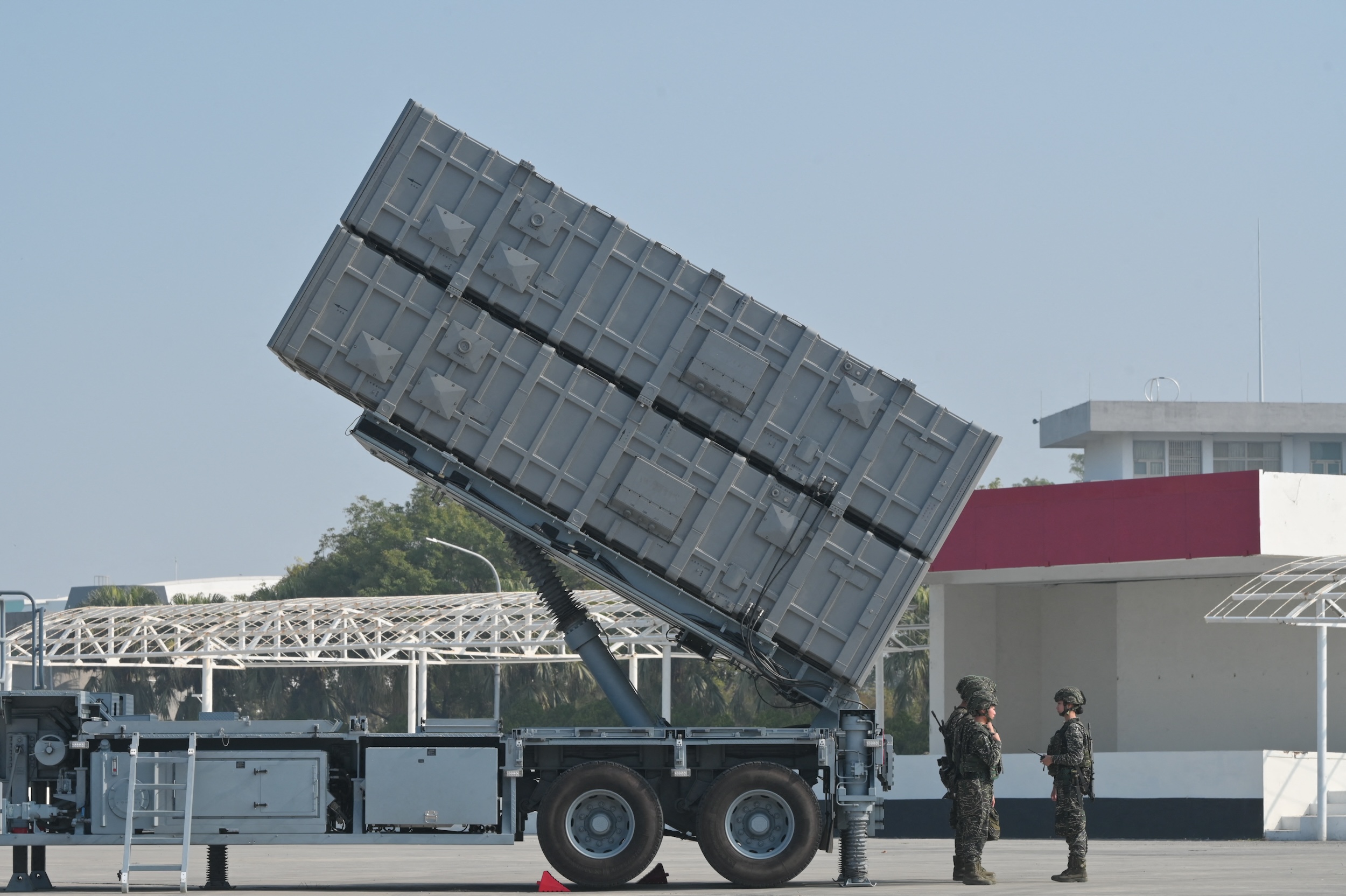
Might China try to attack Taiwan by 2027? The outgoing chief of the US Indo-Pacific Command, Philip Davidson, thought so in 2021, and he recently reaffirmed his assessment. But whether the United States and China are destined for war over the island is another question. While the danger is real, such an outcome is not inevitable.
China considers Taiwan a renegade province and a remnant of the Chinese civil war of the 1940s. Although US-China relations were normalized in the 1970s, Taiwan remained a point of contention. Nonetheless, a diplomatic formula to paper over disagreement was found: Chinese on both sides of the Taiwan Strait agreed that there was just ‘one China’. For the Americans, refusing to recognize any de jure declaration of independence by Taiwan would ensure that the island’s relationship with the mainland would be settled by negotiation, not force. China, however, never ruled out the use of force.
For years, the US policy was known as ‘strategic ambiguity’, but it could be better described as ‘double deterrence’. The US wanted to deter China from using force, but also to deter Taiwan from provoking Beijing by declaring formal independence. That meant providing Taiwan with weapons for its self-defense, but not issuing a formal security guarantee, since that might tempt Taipei into declaring independence.
Thus, when I visited Beijing in 1995 as an official in the Clinton administration and was asked whether the US would really risk war to defend Taiwan, I replied that it was possible, though no one could be sure. I pointed out that in 1950, US Secretary of State Dean Acheson had declared Korea to be outside our defense perimeter; yet within the year, Chinese and Americans were killing each other on the Korean Peninsula. The lesson of history was that China should not take the risk.
The next year, after I had left government, I was asked to join a bipartisan group of former officials to visit Taiwan. We met with President Lee Teng-hui, whose previous ‘unofficial’ visit to the US had caused a crisis in which China fired missiles into the sea and the US deployed carriers off the coast of Taiwan. We warned Lee that if he declared independence, he could not count on American support. Such was ‘strategic ambiguity’.
For a half-century, despite differences of interpretation, the one-China formula and the US doctrine of strategic ambiguity kept the peace. But now, some analysts are calling for greater strategic clarity about the defense of Taiwan. They note that China has become much stronger than it was in 1971 or 1995, and that it is objecting more vociferously to episodes like then-Speaker of the House Nancy Pelosi’s visit to Taiwan in 2022. Adding further to the potential for instability, Taiwan’s two most recent presidents are from the Democratic Progressive Party, which officially favors independence, and polls show that most Taiwanese do not consider themselves Chinese. Can double deterrence still work?
For his part, US President Joe Biden has made four statements suggesting that he would defend Taiwan if China were to use force. But each time, the White House has ‘clarified’ that America has not changed its policy. The administration thus has tried to bolster its military deterrence against a Chinese attack, while not provoking China into riskier behavior by questioning the one-China policy. The goal is to extend the status quo indefinitely.
Will it work? According to Henry Kissinger, who brokered normalization in the 1970s, Mao Zedong told Richard Nixon that China could wait a century for the return of Taiwan. But China’s current leader, Xi Jinping, has sounded much more impatient. His primary concern is control of the Communist Party of China and ensuring its continued control of China. Though a failed invasion of Taiwan could jeopardize both, a declaration of Taiwanese independence also could make him feel threatened at home and more willing to take big risks.
Public officials’ words can affect this delicate balance. But in diplomacy, actions speak loudest, and there are several moves that the US could make to increase deterrence. Since an island of 24 million people can never militarily defeat a country of more than 1 billion, Taiwan must be able to mount resistance that is strong enough to change Xi’s calculation. He must be made to understand that he cannot possibly pull off a quick fait accompli. To that end, Taiwan needs not only advanced aircraft and submarines, but also shore-to-ship missiles that can be hidden in caves to outlast a Chinese first strike. It must become a porcupine that no power can swallow quickly.
As an island 100 miles (160 kilometers) off the Chinese coast, Taiwan does benefit from a vast moat that makes an invasion difficult. But the sea also means that China could enforce a naval blockade to squeeze Taiwanese into submission. Taiwan therefore needs to boost its stockpiles of food and fuel, and the US and its allies must make clear that they would not respect a Chinese blockade. That means positioning American military systems in Japan, Australia, and the Philippines that can reach Taiwan within a week. This would reduce the ambiguity in US deterrence.
At the same time, the US should not give up the basic features of double deterrence. Preventing a war requires showing China that the US and its allies have the capacity to defend Taiwan, and reminding the island’s leaders that a de jure declaration of independence would be provocative and is unacceptable. Much has changed since Nixon and Mao invented the one-China formula. But that formula, if combined with the other steps outlined above, can still help avert a war over Taiwan.
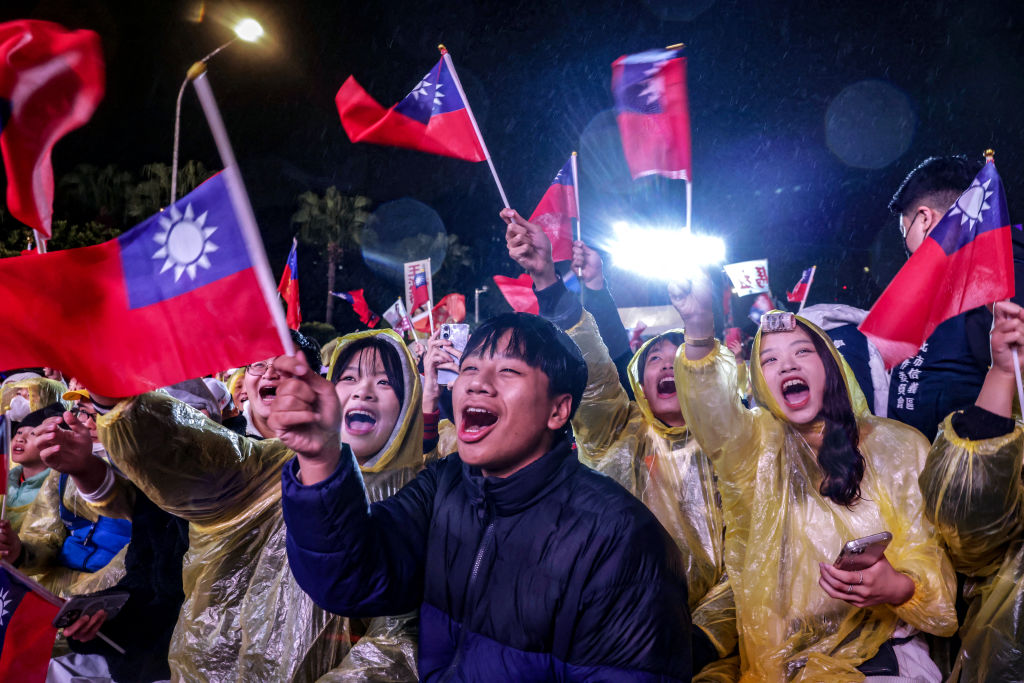
International media are brimming with pronouncements that the West is in decline. The institutions that have formed the foundation of the rules-based international order since World War II are on the brink of collapse, we are warned, and the principles that underpin our open societies have been eroded.
These claims are not baseless, and there is plenty of reason to pay attention to them. But it is too soon to write off the West, let alone democracy. At the very least, we should wait to see what happens over the course of this year, when elections will be held in countries representing half the global population.
Of the elections that have taken place so far, Taiwan’s recent presidential and legislative polls are the most significant. Given the island’s role in US-China rivalry—which can be understood as a contest between democracy and autocracy—the vote may turn out to be a kind of bellwether.
That would be good news. Though the Democratic Progressive Party lost its parliamentary majority to the Chinese Nationalist Party (Kuomintang, or KMT), Taiwanese voters chose the DPP candidate, Lai Ching-te (also known as William Lai), as their next president. Voters showed that they prefer continued democratic governance and greater engagement with the world, not least the West, to subservience to China (and, ultimately, reunification).
Not surprisingly, China’s government has not exactly welcomed Lai’s victory. Last year, when then-Vice President Lai visited the United States, the Chinese Foreign Ministry called him a ‘troublemaker through and through’ who ‘stubbornly adheres to the separatist position of Taiwan independence.’ Since the election, Chinese officials have warned that, as president, Lai would put cross-strait relations in ‘severe danger.’
Equally ominous, while the DPP described the elections as pitting democracy against autocracy, the KMT framed the choice as one of war or peace. And the day before the vote, a Chinese defence ministry spokesman pledged to take ‘all necessary measures’ to ‘smash’ separatist plots ‘in any form.’ This has raised fears that China will pursue reunification—which Chinese President Xi Jinping considers a ‘ historical inevitability’—more forcefully in the wake of Lai’s victory, possibly even launching a military invasion of the island.
China’s current economic troubles—including slowing growth, soaring youth unemployment, falling foreign investment, declining exports, property-market turmoil, and deflationary pressure—might make such action more likely. As Russian President Vladimir Putin and others have shown, nothing distracts people’s attention from declining living standards quite like a nationalist crusade.
Reunification by force would have far-reaching consequences. For starters, it would upend the fragile balance in the US-China rivalry. The US has long maintained a policy of ‘strategic ambiguity‘ toward Taiwan, but were China to invade the island, the US would finally have to decide: let China take what it wants or defend Taiwan from Chinese forces, resulting in a dangerous clash between the world’s two biggest military powers.
Then there are the economic implications. The Taiwan Strait is central to global maritime trade: last year, 88% of the world’s large container ships passed through it. Moreover, Taiwan produces more than 60% of the world’s semiconductors, and over 90% of the most advanced chips. With this in mind, Bloomberg estimates that a war over Taiwan would cost the world about $10 trillion, or 10% of GDP—far more than the 2008 global financial crisis, the Covid-19 pandemic, or the Ukraine war.
Fortunately, there is little reason to think that Lai’s electoral victory will trigger an immediate Chinese invasion. In fact, Xi’s response to the vote has so far been muted. Perhaps he has decided to limit his sabre-rattling over Taiwan in the run-up to the US presidential election, for fear that it would give a boost to the likely Republican nominee, Donald Trump, who made confrontation with China a central theme of his first term in office.
Western leaders have walked a fine line in their responses to the Taiwanese election. While US Secretary of State Antony Blinken congratulated the island’s people for ‘demonstrating the strength of their robust democratic system and electoral process,’ US President Joe Biden reiterated that the US does not support independence.
Similarly, the German Foreign Office released a statement noting ‘how much [Taiwanese] voters aspire to democratic values’ and expressing a desire to expand its relations with the island—but only ‘within the framework’ of the one-China policy. The French Foreign Ministry noted that the ‘free elections’ showed ‘how firmly democracy is rooted in Taiwan,’ but did not mention Lai by name.
Even these tactful responses may get under China’s skin. After all, the Communist Party of China has long claimed that liberal democracy is incompatible with Chinese culture. In this sense, a prosperous, democratic Taiwan is the CPC’s worst nightmare. And as Western leaders have highlighted, a prosperous, democratic Taiwan is precisely what we have today.
Taiwan’s democracy is all the more impressive for being so young: the island’s first presidential election was held only in 1996, after four decades of martial law under the KMT. Today, Taiwan is considered one of only three consolidated democracies in Asia, along with Japan and South Korea.
The recent Taiwanese elections re-affirmed the liberal-democratic values that are under attack in much of the world—and unequivocally rejected the alternative. As Lai put it in his victory speech, Taiwan ‘will continue to walk side by side with democracies around the world.’ If elections elsewhere this year yield similar results, the island will continue to have plenty of companions.
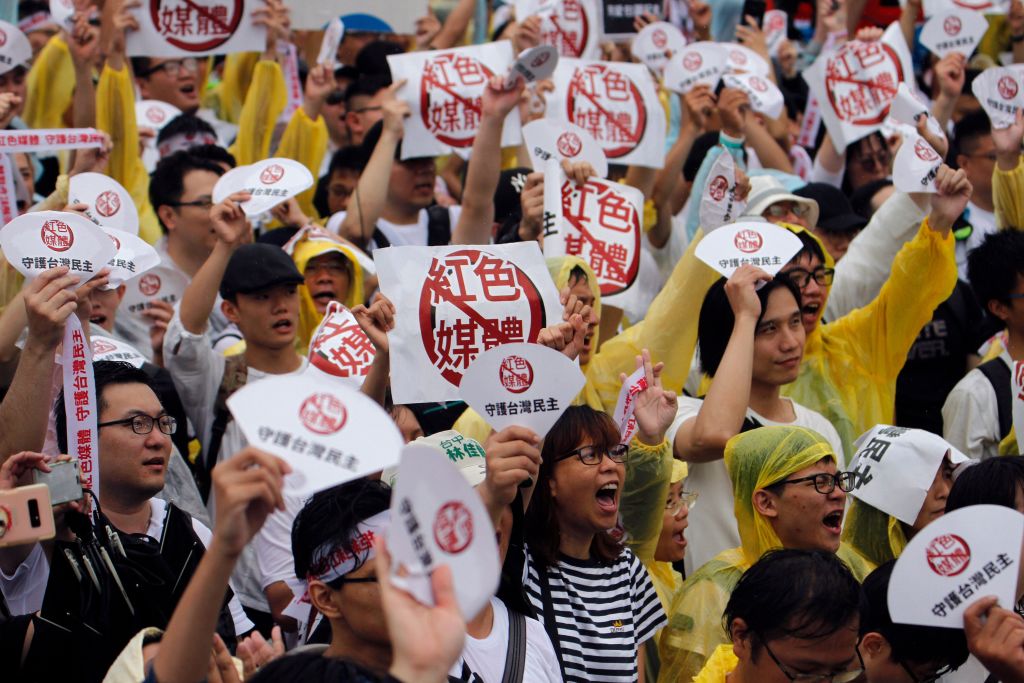
ASPI has identified multiple attempts by the Chinese Communist Party (CCP) to manipulate Taiwanese voters by spreading disinformation and propaganda across social media. These influence operations primarily sought to undermine Democratic Progressive Party (DPP) presidential and legislative candidates. We assess they likely had a minimal impact on the integrity of the election results due to the resilience of Taiwan’s civil society. Partial credit must also go to the Taiwanese government for its efforts to raise public awareness of electoral interference, and a crackdown on other illicit activities, such as the spreading of fake polls.
We observed at least two China-originated threat actors seeking to interfere in this election. We believe one is likely linked to the CCP’s largest network of inauthentic social media accounts known as Spamouflage or Dragonbridge. This network evolved its online influence capabilities by utilising AI-generated avatars and amplified the contents of a document it called ‘The Secret History of (outgoing president) Tsai Ing-wen’. Another China-based actor we assess is likely linked to the first coordinated inauthentic behaviour (CIB) network identified in Meta’s 2023 third quarter adversarial threat report. This second threat actor conducted more sophisticated cyber-influence operations, including disseminating what it claimed were leaked Taiwanese government documents, and a fake DNA paternity test.
The key takeaway for other democracies with elections in 2024 is that they must not become complacent because the CCP is likely to replicate and improve its tactics in more divided and less resilient electorates where they may be more effective. We found that some of the inauthentic social media accounts trying to sway Taiwanese voters were also spreading anti-Bharatiya Janata Party (BJP) and anti-Indian government content, presumably to impact public sentiment before India’s elections this year. These accounts are primarily targeting audiences in India’s northeast region of Manipur, where India has suspected Beijing of aiding insurgent groups to destabilise the region.
The Spamouflage-affiliated accounts on X/Twitter (see image below), Facebook, Medium and Taiwanese blog sites called for a change in government and accused DPP presidential candidate Lai Ching-te of corruption and embezzling military procurement expenses. They named him and vice-presidential candidate and former representative to the US, Hsiao Bi-khim, as ’America’s pets’. The most common narrative spread by these accounts accused Lai and Hsiao of secretly signing a NT$2 trillion (US$65 billion) arms purchase from the US to help the DPP win the election. There are no authoritative reports of such a deal and the claim was almost certainly disinformation.
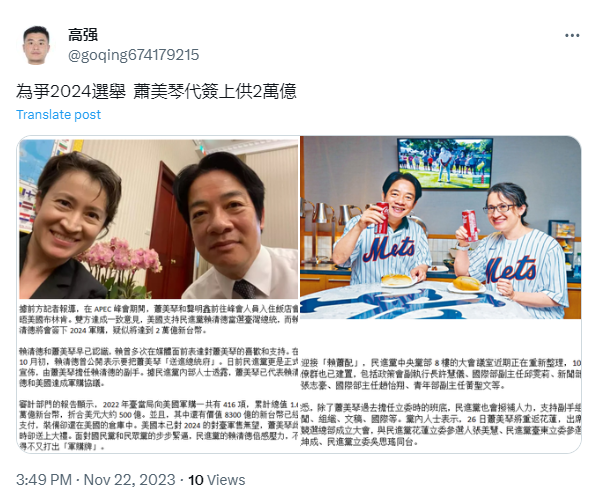
The posting patterns and timelines of these accounts suggested they were very likely linked to the Spamouflage network, which has links to Chinese law enforcement and coordinates with other agencies such as the Ministry of Foreign Affairs and the United Front Work Department according to internal group communications revealed by the US Department of Justice. Accounts targeting Lai and Hsiao were involved in previous Spamouflage campaigns targeting Chinese virologist Yan Limeng, Chinese businessman Guo Wengui, and Chinese dissidents. They also spread disinformation about Japan’s release of treated wastewater. These accounts tended to post between 9am and 9pm—Beijing business hours. While Spamouflage accounts were active throughout 2023, ASPI observed this network significantly increasing posts attacking the DPP after the KMT and TPP joint presidential ticket collapsed on 16 November 2023.
Spamouflage-affiliated accounts sought to harass DPP legislative candidates too, calling the DPP’s Lin Ching-yi, a ‘shameless’ politician. Accounts would reply en mass to her posts and troll or claim she was ‘taking advantage of men to get ahead’ (#林静仪借男人上位). These tactics were reminiscent of previous harassment and psychological targeting of women with Asian heritage which were intended to silence their public profiles and damage their mental health. Lin also faced negative news coverage throughout the year in the Straits Herald, a news outlet sponsored by the Fujian Daily, the official newspaper of the Fujian Provincial Committee of the Chinese Communist Party, which alleged falsely that she plagiarised her master’s thesis. Lin lost her seat to KMT challenger Yan Kuan-heng.
Other politicians targeted by the network included Lin Feifan, the former deputy secretary-general of the DPP, and Taiwan’s Foreign Minister, Joseph Wu, who Spamouflage accounts accused of sexually harassing female colleagues and having affairs. Posts targeting Wu would often use the #METOO hashtag and have images of him doctored to include women (see images below).

Starting on 2 January 2024, Spamouflage-linked accounts began flooding social media platforms, including X/Twitter, Facebook, Reddit, WeChat and TikTok, with posts about a 318-page document called ‘The Secret History of Tsai Ing-wen’ (蔡英文秘史), which falsely accused Tsai of corruption and promiscuous behaviour. The document was originally uploaded on Zenodo, an open-source data repository previously used by Spamouflage-linked operators to upload a document claiming Covid-19 originated from the US. Most of the document’s metadata had been removed but enough remained to indicate that the document was created by ‘WPS 文字’, a word processor developed by Chinese software company Kingsoft and commonly used only in mainland China. To provoke further online attention, a link to the document was spammed to prominent Chinese-language online commentators.
On YouTube, Spamouflage-linked channels posted at least 490 videos referencing the ‘secret history’ document between 4 January and 10 January before YouTube suspended all the channels. As noted by the Taipei Times, these videos involved the use of AI-generated content and some videos had been edited using Capcut, a software developed by ByteDance. In addition, ASPI found other companies possibly complicit in creating these videos. At least one video appeared to have used a ‘speaking portrait’, a photorealistic AI-generated avatar created by D-ID, a US-based software company. ASPI is not suggesting that D-ID knowingly cooperated with Spamouflage-linked operators. However, the presenter used in the video (see images below) requires users to have a paid subscription to D-ID’s platform.

Another video posted by Spamouflage accounts appeared to have been generated with the Weta365 app (see images below) launched by Mobvoi, an AI company founded by ex-Google scientist Li Zhifei with funding from Sequoia Capital China, Google and Volkswagen. One of the case studies on Weta365’s website shows the application being used by Chinese police officers for training videos, which implies that there may be deeper cooperation between Mobvoi and Chinese security or intelligence services.

The CCP is now comfortably leveraging AI-generated content as a cornerstone in its influence operations and propaganda arsenal. In late 2023, ASPI observed a similar but distinct China-originated coordinated inauthentic influence campaign on YouTube using entities and voiceovers generated by AI to promote narratives such as China is winning the US-China technology war. This network of YouTube channels attracted just under 120 million views and 730,000 subscribers. With Spamouflage adopting similar tactics, the possibility of the network amassing significant online audiences with AI-generated content is a concerning development, especially outside closely monitored election periods.
In addition to Spamouflage activity, ASPI observed another likely CCP-linked online threat actor seeking to interfere in Taiwan’s election that was more targeted and operated more sophisticated personas. On 17 December 2023, an anonymous user uploaded an alleged leak of Taiwanese government documents on the hacking crime forum, BreachForums. One of the documents claimed Taiwanese military intelligence funded a podcast called ‘Complicated Things in a Nutshell’ (繁事簡單說) as part of Taiwan’s media warfare against the mainland. The BreachForum’s post was then shared at least 82 times on X/Twitter, before HK01, a Hong Kong-based online news site launched by pro-Beijing businessman Yu Pun-hoi, was said to have been emailed similar documents and reported about them on 4 January 2024.
On 7 January 2024, another anonymous BreachForum user named ‘jt53ur39’ uploaded a fake DNA test purporting to show that Lai Ching-te had an illegitimate child. We agree with Radio Free Asia’s Fact Checking Laboratory’s assessment that the DNA report was likely fake. The numbers representing the allele sizes were not properly aligned down the columns and there was no conclusion in the interpretation box that is expected in typical reports. Jt53ur39’s forum post was first shared on 4chan from an IP address originating from Thailand. ‘Lai Ching-te’s illegitimate son’ (賴清德私生子) was then mentioned nearly 20,000 times on X/Twitter, Facebook, YouTube and other online forums by inauthentic accounts that had also previously shared links to the alleged Taiwanese government document leaks. The number of such posts peaked on 12 January, the eve of the election, with over 13,000 mentions that day alone. This coincided with reporting on the allegation by the China Times, a Taiwan-based newspaper that reportedly takes instructions directly from the CCP’s Taiwan Affairs Office.
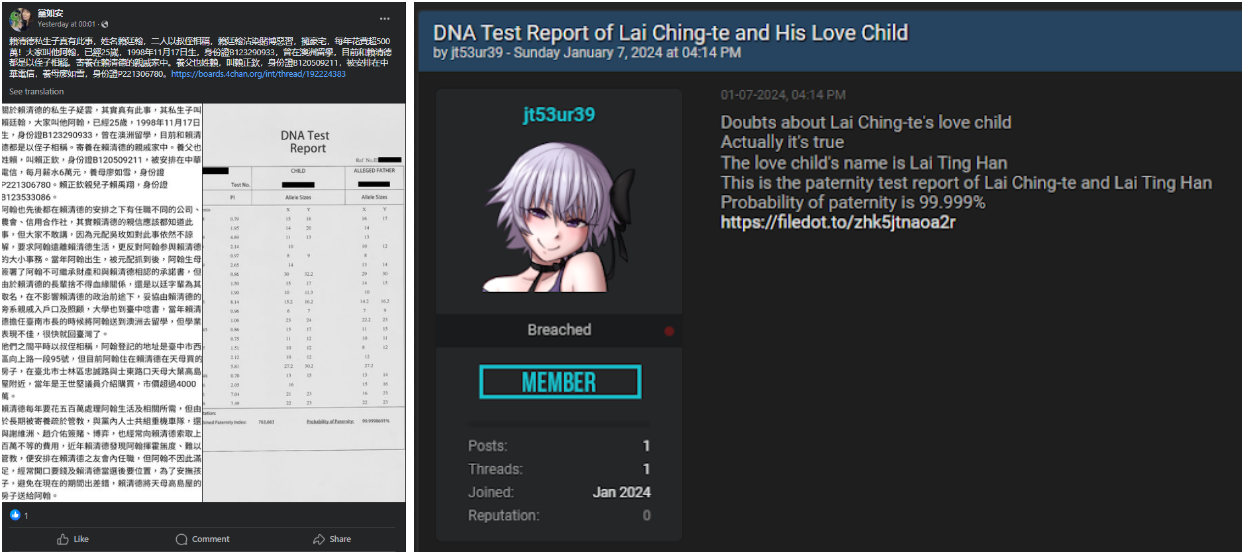
We assess that the network of inauthentic social media accounts sharing links to the Taiwanese government document leaks and the fake DNA test is likely linked to a China-based CIB network targeting India, Tibet and the US. Almost all of the X/Twitter accounts had retweeted @NickJonas154141, an account identified as being acquired by a China-based CIB network in Meta’s 2023 Third Quarter Adversarial Threat Report. Like that CIB network, all the accounts in the new network posed as Indian citizens and posted anti-BJP or anti-Indian government content that primarily targeted users in Manipur.
The account, Ayush Satyal, identifies as being located in Nepal and has over 100 followers but appears to have stolen the profile image of Kapil Gnawali, a Nepal-based engineer not linked to the China-based network. Ayush Satyal frequently uses the #Manipur hashtag, retweets NickJonas154141, shares posts about Lai’s DNA test on BreachForums (which is the only Chinese-language post on his profile) and calls for Indians to never vote for the BJP because of its activities in the Manipur region (see images below).
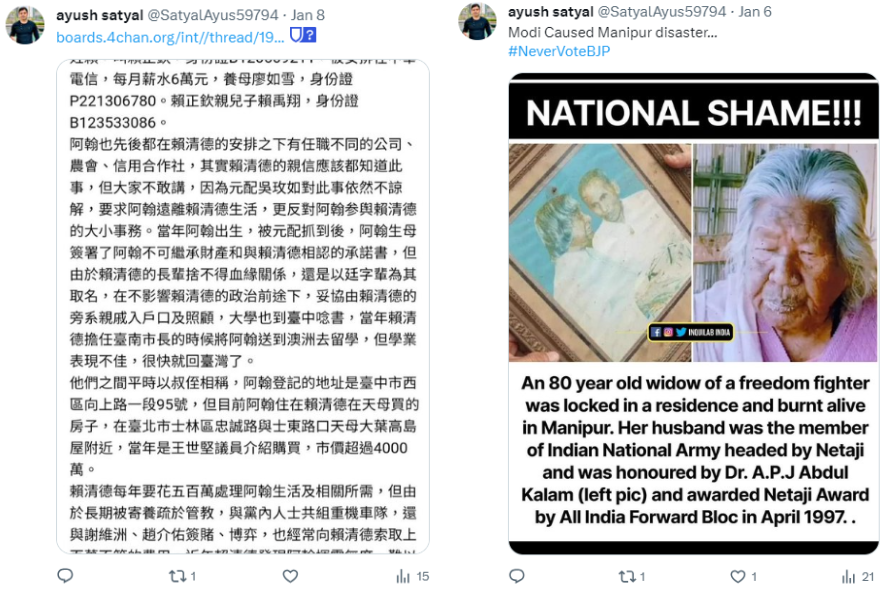
It’s difficult to assess the effectiveness of the CCP’s influence operations in these elections. More research could be collected on Taiwanese sentiments leading up to the election and how specific CCP-fueled narratives influenced opinions. Taiwan elected DPP candidates Lai and Hsiao, which suggests the CCP was ineffective in swinging the vote. But the DDP lost its majority in Taiwan’s parliament, the Legislative Yuan. That could in part be due to the CCP’s amplification of anti-DPP content but it’s more likely to be Taiwanese people expressing dissatisfaction with the DPP’s domestic policies and the increased cost of living.
The prevalence of two known China-based networks, Spamouflage and the India-focussed CIB network, on social media platforms shows that X/Twitter is failing to ensure online safety during a year of important elections. Of all the X/Twitter accounts listed in Meta’s 2023 Q3 Adversarial Threat Report as having been acquired by a China-based CIB network, only one out of seven has been suspended by X/Twitter. Other platforms such as YouTube and Meta are being proactive and taking down state-backed influence operations when they are detected. However, the research community still lacks access to archives of these takedowns. That access would enable independent investigators to study new threat actors and force platforms to be more transparent in content moderation decisions.
The burden of preventing electoral interference must also extend to emerging Western generative AI companies. A laissez-faire approach to online safety could damage democracy and lessen public trust. OpenAI’s announcement of a series of new initiatives to protect the integrity of elections is a welcome start but OpenAI should also publicly release threat reports of malicious state and non-state actors misusing their products as do social media platforms. Companies like Synthesia and D-ID, whose products are being co-opted by authoritarian intelligence and military services, must be more rigorous in their due diligence regarding their clients, or governments should consider making generative AI companies liable for defamation or facilitating electoral interference.
Likewise, Western governments and companies need to reassess their foreign direct investments into China’s AI industry if the products they are funding, such as Mobvoi’s Weta365 generative AI app, are likely to be used in political warfare operations against democratic states. There are no low-risk investments in China’s dual-use AI sector. Any Chinese AI company that is likely to succeed with a high return on foreign investment, will at the same time have the capabilities that the CCP desires to modernise its military or intelligence services and will be required to cooperate because of Beijing’s National Intelligence Law.
Democracies conducting elections later this year, such as India, Indonesia, the UK and the US, should strengthen their relationship with Taiwan and the new Lai Administration. India and Taiwan should share intelligence on CCP threat actors active in the recent Taiwanese election and jointly investigate the China-based inauthentic social media accounts targeting India’s Manipur region. Taiwan should share an intelligence memo about a December 2023 meeting between senior Chinese leaders from the Propaganda Department, the Ministry of State Security, the Ministry of Defence and the Taiwan Affairs Office to consolidate their influence operations targeting the Taiwan election.
The success of Taiwan’s whole-of-society counter-disinformation and propaganda efforts is primarily due to the efforts of civil organisations, including DoubleThink Lab, the Information Environment Research Center, the Taiwan FactCheck Center, Cofacts, Kuma Academy and many others. These organisations often investigate malicious online activity before government agencies can respond and counter false narratives in real time. They are themselves the targets of the CCP’s propaganda apparatus.
Their collaborative approach demonstrates that defending against disinformation and electoral interference is not something organisations or states should face alone.
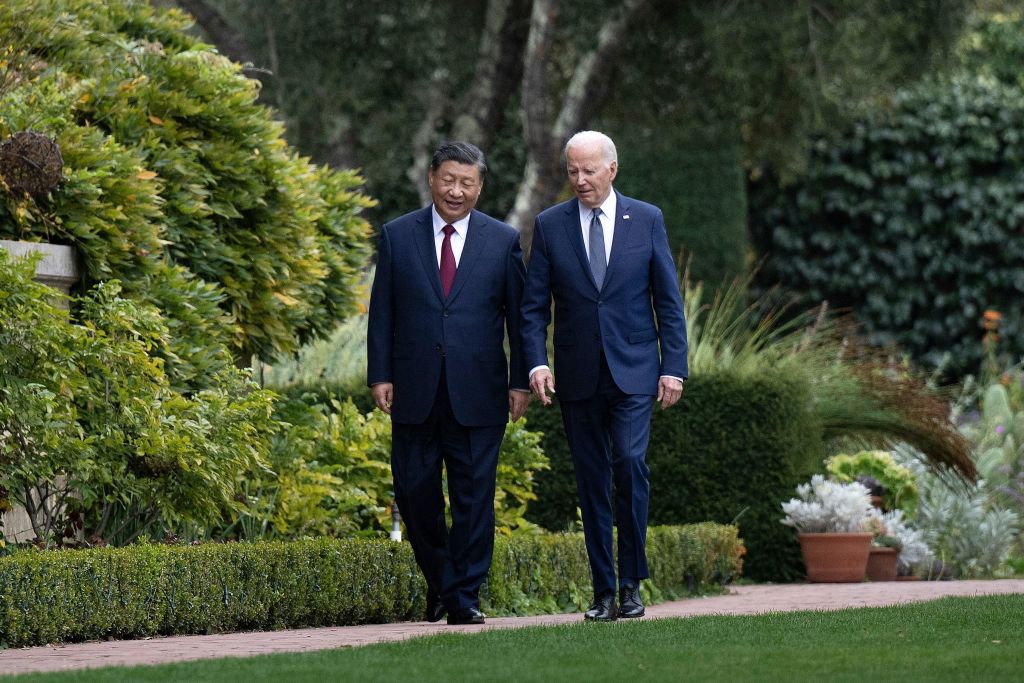
Summits are by definition occasions of high politics and drama, so it comes as little surprise that the 15 November meeting between US President Joe Biden and Chinese President Xi Jinping generated immense global interest. It was a useful meeting: Biden and Xi agreed to restart military-to-military communications, curb the deadly opioid fentanyl, fight climate change and discuss risks associated with artificial intelligence. But it was also something less than a reset of a relationship that has been deteriorating for several years and that will remain typified by competition more than anything else for the foreseeable future.
Both leaders came to San Francisco hoping the four-hour meeting (held alongside the APEC forum) would place a floor (to use Biden’s favourite image) under what is the defining bilateral relationship of this era. But it’s worth noting that their motives differed fundamentally. Biden wanted to reduce tensions, since the last thing he needs is another diplomatic or, worse, military crisis at a time when an overstretched United States is contending with Russian aggression against Ukraine in Europe and the after-effects of Hamas’s 7 October terrorist attack in Israel.
Biden, a year away from the 2024 presidential election, also needed to show he could be tough on China, both to parry Republican attacks and to show that he was focused on issues that are touching American lives. In this regard, he successfully pushed China to pledge to do more to rein in its exports of the chemical precursors that cartels in Mexico use to manufacture fentanyl.
Xi, for his part, came to California somewhat weakened, owing to the Chinese economy’s underperformance. Following years of excessive state intervention since Xi came to power a decade ago, youth unemployment is high, exports and foreign direct investment are down, and debt is a major issue. The last thing Xi and China’s economy need are more US export controls, sanctions and tariffs.
What did not change as a result of the conversation was the status of the most contentious issue dividing the US and China: Taiwan. For the past half-century the two governments have finessed the issue, essentially agreeing to disagree over the ultimate relationship between the island and the People’s Republic. Xi sees unification as central to his country’s future and to his own legacy; the US sees protecting Taiwan from coercion as central to America’s standing with its allies in the region and the fate of a rules-based international order. It’s likely that tensions stemming from these contrasting agendas will periodically spike in the future as in the past.
One piece of good news in this context was the agreement to re-establish military-to-military communications, which China cut off in the wake of House Speaker Nancy Pelosi’s trip to Taiwan in August 2022. This is welcome in principle because it reduces the chances of an incident involving US and Chinese aircraft or ships, which operate in close proximity to one another on a daily basis. But whether this channel could be relied upon if an incident occurred, and, if so, to what effect, remains an open question.
The summit appeared to produce the promise of enhanced US–China cooperation on climate change and on regulating the use of AI. What will matter, though, is whether the spirit of that promise ultimately translates into meaningful concrete action.
The summit didn’t appear to bridge Chinese and American differences over the world’s two major ongoing conflicts. China is very much in Russia’s corner, while the US is in Ukraine’s, and China (unlike the US) has distanced itself from Israel in the wake of the 7 October attack, refusing to condemn Hamas and calling for an unconditional ceasefire.
Despite these differences, the two governments don’t appear to be on a collision course in either region. China has held off on arming Russia, and it has a stake in not seeing conflict in the Middle East escalate to a point that jeopardises its ability to import Iranian oil. Xi also wants to avoid a scenario where mounting geopolitical differences over either of these crises provide a pretext for the US to take additional steps that would add to China’s economic difficulties.
But it remains to be seen whether such calculations on Xi’s part will lead China to exercise restraint in the South China Sea, where it has been applying increasing pressure against the Philippines, a long-standing American ally. And the summit provided no reason to believe that China is prepared to use its influence to rein in the nuclear and missile programs of North Korea.
Over seven decades, the modern US–China relationship has evolved significantly. Early on, there was no relationship to speak of, and the US found itself in an armed confrontation with China during the Korean War. That was followed two decades later by a period of strategic cooperation against the Soviet Union, and then to boost trade and investment as a joint priority once the Cold War ended. But economic ties have become a source of friction in recent years, and as China became increasingly assertive, the two countries found themselves increasingly at odds over just about everything, from regional and global issues to human rights.
The San Francisco summit didn’t alter this reality. US–China relations remain an issue to be managed, not a problem to be solved. Expecting anything else from the summit was to expect too much. The world’s most important bilateral relationship continues to be a highly competitive one, and the challenge remains what it was prior to the summit: to ensure that competition doesn’t preclude selective cooperation or give way to conflict.
Sorry, no posts matched your criteria